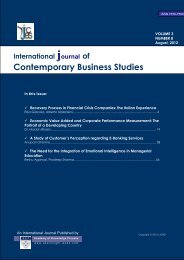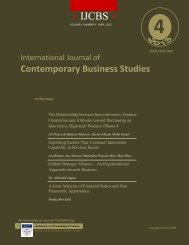International journal of Contemporary Business Studies
International journal of Contemporary Business Studies
International journal of Contemporary Business Studies
Create successful ePaper yourself
Turn your PDF publications into a flip-book with our unique Google optimized e-Paper software.
<strong>International</strong> Journal <strong>of</strong> <strong>Contemporary</strong> <strong>Business</strong> <strong>Studies</strong><br />
Vol: 3, No: 6. June, 2012 ISSN 2156-7506<br />
Available online at http://www.akpinsight.webs.com<br />
In a study to explore relationship between organization structure and perceived innovation <strong>of</strong> India<br />
manufacturing sector, five components <strong>of</strong> structure are use as the measures: vertical complexity,<br />
horizontal complexity, formalization, centralization, concentration <strong>of</strong> authority and participation<br />
indecision making (Prakash & Gupta, 2008). A positive relationship were established between horizontal<br />
complexity, formalization, participation in decision making and innovation, however negative<br />
relationship between centralization structure and innovation (Prakash & Gupta, 2008). In order to increase<br />
the number <strong>of</strong> innovations, Prakash and Gupta (2008) suggested to focus on the participation in decision<br />
making, decentralization through staff empowerment and informal network within the organization.<br />
Similarly, in the logistic service innovation, the decentralization and formalization structure showed a<br />
positive relationship whereas the specialization structure showed negative relationship (Daugherty, Chen,<br />
& Ferrin, 2011).<br />
Due to the rapid development <strong>of</strong> information technology and to recapture competitiveness in serviceenhance<br />
manufacturing firm, Shen, et al., (2010) has proposed four dimensions for its organizational<br />
structure: self-management, interdependence, centralization <strong>of</strong> power and boundary infiltration. This new<br />
dimension is proposed because it is argued that production based is no longer a traditional manufacturing<br />
companies and thus, they need to change the new organizational structure to meet the new economy<br />
(Shen, et al., 2010). Nevertheless, the role <strong>of</strong> organizational structure is open for arguments. It is noted<br />
that competitiveness issue is also related to the environment factor. Therefore, organizational structure<br />
need to balance the demands for efficiency and flexibility in the high technology firms where it is needed<br />
to facilitate innovation and adapt the dynamic change <strong>of</strong> environment (Sholes, Barnett, & Utley, 2011).<br />
Organization that is operated in a stable environment in terms <strong>of</strong> demand, competitors, low level product<br />
change is best suited by centralized decision making, formal job description and, emphasis on chain <strong>of</strong><br />
command and well process control (Sholes, et al., 2011). On the other hand, decentralize structure is<br />
suited for the dynamic, complex technologies and competitive instable environment (Sholes, et al., 2011).<br />
Since decentralized structure focus on goal specification to allow increase in rates and intensity, its<br />
promotes proactive adaptability and innovation. The situations also differ from the perspective <strong>of</strong><br />
innovation types. For instance, technological innovation which is more complex process is affected by the<br />
R&D level, managerial ability and investment need a structure that have rules and regulation that<br />
encourage creativity, self-directed work and learning, few layers <strong>of</strong> hierarchical to enable quick response,<br />
high level <strong>of</strong> horizontal integration to increase knowledge transfer, decentralized decision making and<br />
high level <strong>of</strong> vertical and horizontal communication to ensure action (Shi & Xin, 2006). Although few<br />
layers hierarchical is better, organization also need to flat organization so that it could made close contact<br />
among employees, department and top management (Wichitchanya, et al., 2012).<br />
1.3Resource Allocation<br />
Consequently, the third managerial lever is resource allocation which is also important in innovation<br />
management. According to Lau, Yam and Tang (2010), resource allocation capability is referred to<br />
firm‟s ability to mobilize and expand its technological, human and financial resources in the innovation<br />
process. It is found that resource allocation has improve the performance rate <strong>of</strong> new product which<br />
contribute to the technological innovation capabilities <strong>of</strong> an organization (Lau, et al., 2010). Besides,<br />
resource allocation is also interdependence with business models and knowledge creation and this has<br />
made the innovation knowledge-intensive environment is depended upon resource allocation as one <strong>of</strong> the<br />
important lever (Grand, Krogh, Leonard, & Swap, 2004). The importance <strong>of</strong> resource is proven by a study<br />
conducted in small medium enterprise in Malaysia where firm resource drive product innovation<br />
performance (Bakar & Ahmad, 2010).<br />
1.4Knowledge Management and Organizational Learning<br />
The fourth managerial lever is knowledge management and organizational learning. Knowledge<br />
management is identified as an important antecedent <strong>of</strong> innovation (Darroch & McNaughton, 2002).<br />
Knowledge management is closely related to organizational learning initiatives (Mundra, Gulati, &<br />
Copyright © 2012. Academy <strong>of</strong> Knowledge Process<br />
9
















